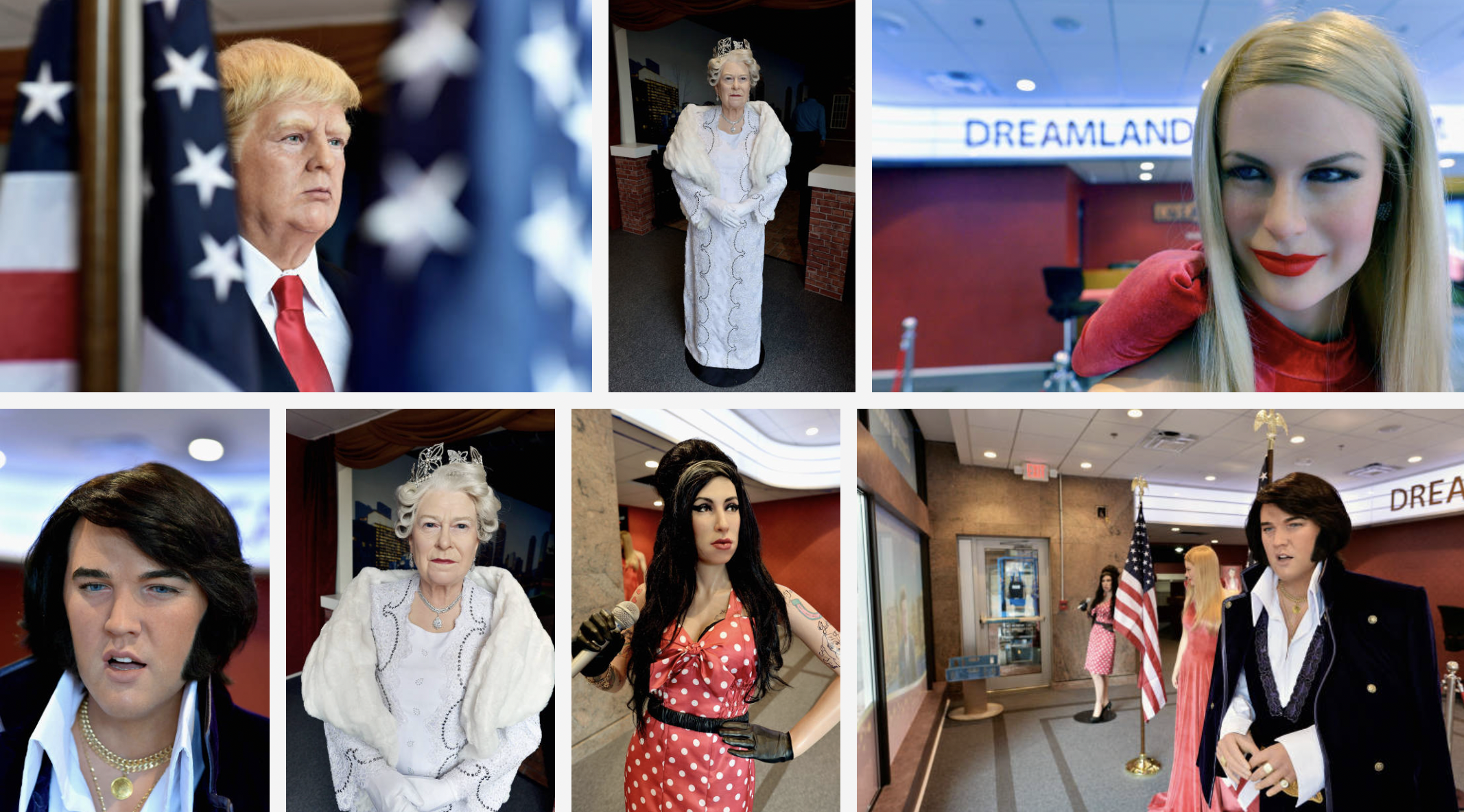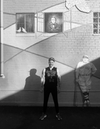That's what makes a wax museum timeless

This piece was originally published in Esquire.
For the first time in history Tom Brady looks like garbage. If it weren't for the number 12 jersey on his back or the football clasped awkwardly in his tiny hands, you wouldn't know it was him. Granted, it's merely a likeness—one of 100-plus wax figures installed at the Dreamland Wax Museum—but if there's anyone you'd want to get just right for your Boston debut, you'd think it'd be him. Brady, who turned 40 the night I stopped by Dreamland, was the second figure that greeted me upon arrival, behind only Abraham Lincoln in the one-two power ranking of historical significance. Marky Mark's "Good Vibrations" thundered over the sound system.
A trip to a wax museum might seem like a weird way to spend an evening, but with so much of the world seeming itself like a distorted hall of nightmares, coupled with the pervasive case of existential dread many of us contend with daily, it felt thematically appropriate. Plus, I was out of weed.

The museum, the latest from Dreamland Wax, opened last week and has already garnered its fair share of attention in local media, not least because of the Brady flub. Its location, overlooking the brutalist monstrosity of Boston's City Hall Plaza, is just steps away from the well-tourist-trod Freedom Trail—Paul Revere ran a goldsmith shop here!—and around the corner from the Old State House, where they invented a little something called America. "What makes us different than other wax museums," Dreamland's vice president of sales Michael Pelletz explained as we walked through the 18,000-square-foot building, "is that half is about history and education first. Then there's the glitz and glamour."
In the future, the artisans who make the figures will ideally design them from a sitting with the famous person, where they'll take some 200 measurements to produce a lifelike mold. Dreamland is already lobbying Brady to come in for a replacement, promising to donate to a charity of his choosing for his time. "A lot of people want to come see Tom Brady. Ninety-three percent say it looks like him," Pelletz said, perhaps anticipating my amused reaction. "Seven percent, I guess really big fans, say no, it doesn't."
Our current president, another nightmare already inducted into the museum, counts as a second misfire, caught in the purgatory between fantasy and reality. Although Trump's avatar was an imposing presence, it was hard to take him seriously—he looked like a hybrid of Lindsay Graham and Frank Caliendo doing his John Madden impression. The hair and skin tone were too realistic.
The reason we're both fascinated and repulsed by wax museums stems from a concept known as the "uncanny valley," which is often applied to robotics and animation. In short, it suggests that as an artificial object approaches true human likeness, there is a point where it becomes repulsive, or uncanny, to us. A robot or wax figure that is roughly lifelike does not present any sort of dissonance in our cognitive acceptance of it, because it's obviously artificial. That's why Trump and Brady were so ridiculous. We are also empathetic toward completely lifelike characters—like those in Westworld or Ex Machina—because they appear human enough to override our natural rejection. But in the middle ground, where things are close enough yet slightly off, like a "good" wax figure, our brains go haywire. Theories abound, but in short, we are reminded of our mortality, invoking a sort of existential dread.
I felt my brain cycling through this over and over as I met a very realistic Albert Einstein, perched alone as if in eternal lecturing repose. A voiceover, Einstein I'm guessing, extolled the relative economic bargain of nuclear annihilation: "The cheapest way to kill people is nuclear weapons. They're really remarkably cheap."
From there we walked to the presidential corridor. The majority of presidents, each posed in front of a hasty mock-up of their historical era, looked much more accurate than the celebrities, probably because we have fewer contemporaneous photographs with which to compare them. Rutherford B. Hayes, in particular, was rather striking and human-like with his beard and slicked-back hair, almost indistinguishable from the type of guy you'd ask to pour you a $17 Negroni (and moving about as fast).
The current day presidents were hit or miss, however. Bill Clinton looked like a Sesame Street actor on a smoke break still wearing the top half of his Big Bird suit. Barack Obama seemed modeled after the lookalike who played the devil in that Son of God movie. Both Bushes held up well by comparison, in particular W. There was something moving about staring into his dead eyes, man to man—or man to avatar, rather—as his post-9/11 speech resounded over the speakers. That gave way to one of Obama's most famous speeches: "I still believe in hope," his voice called out. (He'd better hope for a more flattering bust next time.)
Then, in a jarring bit of juxtaposition, came that voice more familiar to all of us than our own: "The corrupt establishment exists for one reason: to enrich themselves... Our campaign represents a true existential threat like they've never seen before."
"Love him or hate him, he's here," Pelletz said, reminding me of something the president said to Australia's Prime Minister recently regarding the Boston Marathon bombers: "They were from wherever they were."
In the Oscar Party room nearby, Nicole Kidman was honestly beautiful next to Brad Pitt and Leonardo DiCaprio. It was supposed to be a glamorous display of the rich and famous, but it felt more like a wing of hell, each movie star eternally posed silent and unmoving, forced to serve time as recompenses for a life of good fortune.
I roamed further into the hall of humanoid wonders. "Unlike other wax museums, we want you to take a selfie with MLK," Pelletz had said before leaving me. (You can touch things at Dreamland.) I decidedly did not. Nor with Audrey Hepburn, frozen in breakfast confusion across the room from the Queen. Neither did I linger at James Dean, played here by David Spade after a nasty coke bender, or Brillo-haired Mark Zuckerberg, skinny-ass Tiger Woods, or any of the other celebrities who looked cartoonish in their flaws. The comically bungled figures were far enough removed from any resemblance to actual humanity that I could easily disregard them.
But the occasional, almost-perfect replicas sent me toppling downward into the Uncanny Valley. Snoop Dogg and Clint Eastwood's creators, for example, seemed to have imbued them, Dr. Frankenstein-like, with a tiny flickering pilot light of potential soul that disquieted me. Perhaps it was because I was now roaming the halls alone toward the end of the night, a cacophony of nearby Oprah monologues, sports highlights—hello, Larry Bird!—and movie dialogue clouding my brain. I stood toe-to-toe with stoic Eastwood and sized him up, and, lifeless as he was, he nonetheless backed me down. A "You've got mail!" sound effect from the nearby nerd prison housing Bill Gates, Zuck, and Steve Jobs shocked me back into the present.
"It's magical," Pelletz told me when I emerged to "Good Vibrations" playing again, the musical loop having run its course. "If you're studying history, or you see Leonardo DiCaprio in a movie, you can come here and feel like you're close to him, because how many people get to meet him?"
"It's the same with some of the presidents that have passed away, like Abraham Lincoln or John F. Kennedy," he continued. "That's what makes a wax museum timeless. You can only read about it so much, or see it on TV, but to be able to touch them and put your arms around them and get up close, it bring history to life."
Before I left, there was one last piece of business to contend with. Earlier I'd stepped into a 3D photograph chamber and had an image of myself made. Guests can choose to have these turned into small toy figurines of themselves for an additional price. The results had been sent to my phone, a GIF of myself rotating and rotating, my expression fixed and unwavering. The Every Time I Die T-shirt I'd chosen to wear that day seemed accidentally appropriate. One of us, the wax figures whispered from around the corner. One of us.
Soon after I walked across downtown Boston over to the Common, where a Shakespeare in the Park production of Romeo and Juliet was winding down. I laid on the grass and watched living people pretend to be dead.
